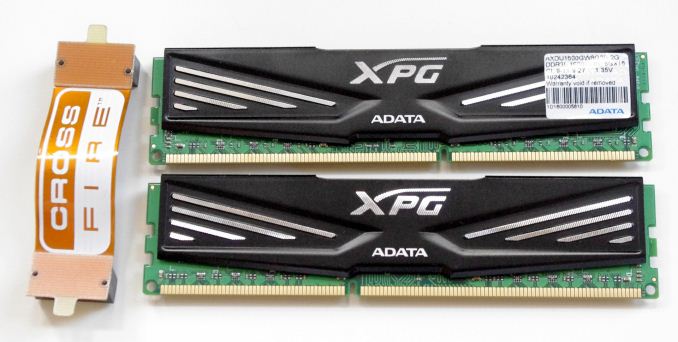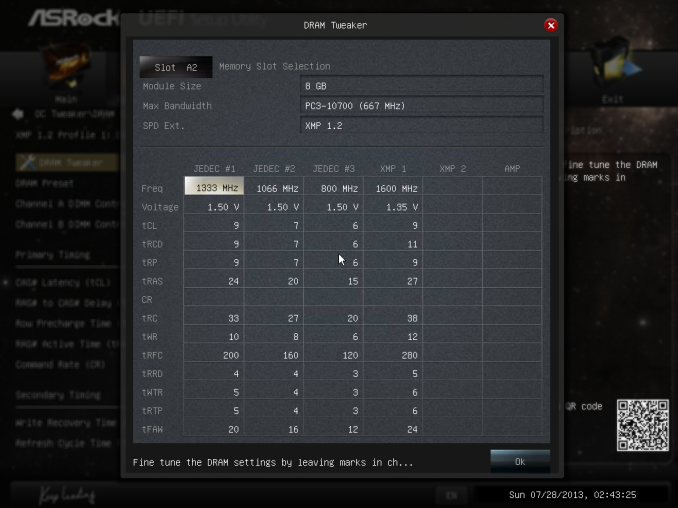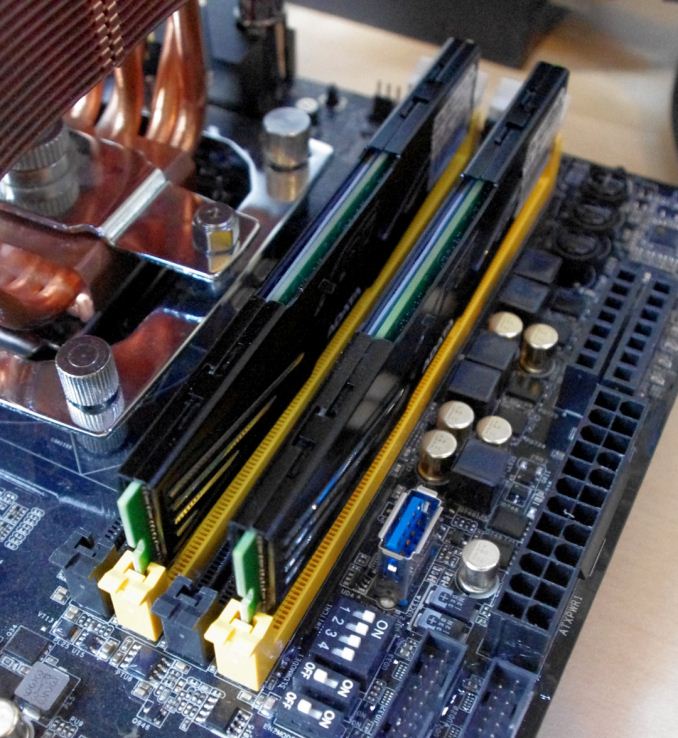ADATA XPG V1.0 Low Voltage Review: 2x8 GB at DDR3L-1600 9-11-9 1.35 V
by Ian Cutress on December 6, 2013 2:00 PM EST
For the next in our series of memory reviews on Haswell, we have another ADATA kit to test: this time a low voltage 2x8 GB kit featuring DDR3-1600 C9 timings. Being lower down the chain on a SKU list, the heatsinks are also smaller than the ones previously tested, and come in at £125. Previously in our big roundup of Haswell testing we suggested 1866 C9 being the minimum people should consider: would going 1600 C9 LV matter that much in results?
ADATA XPG V1.0 2x8GB DDR3L-1600 C9 1.35V Overview
ADATA’s line away from the more extreme (2400+) memory setups is aimed more conservative. If they were to use the same DRAM chips on board, those 2400 MHz C10 kits might hit lower voltages or lower CL numbers when we move down to 1600 MHz, so there is some potential in diversifying the product line of the same ICs as long as the market is there.
The AXDU1600GW8G9B-2G kit we are testing today is very unassuming next to those higher end modules – a simple small metallic based heatsink. When using a large air cooler like my TRUE Copper, they were easy enough to fit in unlike some of the larger modules.
The lower voltage element of memory intrigues me, most likely for the wrong reasons. The difference between 1.50 volt and 1.35 volt memory, in an overall system build, is not going to affect power draw in a measurable way. If you were building a 42U rack of servers, then yes, multiply out the DRAM modules you need across all the sockets and it can make sense if they are going to be active all the time. But at this juncture, even when a system draws sub 30W on idle and under 100W load, I cannot see a picture where moving from 1.50V to 1.35V makes a sizeable difference to a yearly electricity bill. Others may argue this point, but finding consistent data that converts to a decent power saving is hard to produce or come by. It would be more applicable to buy a lower TDP CPU (such as the i7-4765T, or E3-1230L V3) instead. That leaves a bit of e-peen for being low powered and green as positives, and the kit obviously has to stand on its own two feet when we push through the benchmarks.
In our big memory round-up for Z87 and Haswell, our cautionary tale was that slower MHz (under 1866) kits, rather than being restrictive, have a few holes in their performance on certain benchmarks, causing a 10-20% performance drop compared to the asymptotic limit hit when you go beyond 2133-2400 MHz. This ADATA 1600 C9 Low Voltage kit hits a couple of pot holes in that regard: WinRAR could be faster, as well as some of the minimum frame rates on a few games.
For Overclocking, our kit comes out of the bag with a Performance Index (PI) of 178: we pushed this to a PI of 200 (2000 10-12-10) with very little effort. This is a bit different from the PI of 240-260 which we see on the higher end kits.
Price wise, 2x8 GB 1600 C9 memory kits can be found for under $150 – the cheapest on Newegg today is actually a 1.35V kit for $129, followed by a 1.65V kit for $130. ADATA do not list this kit on Newegg, but in the UK the pricing is around £125 – if you take off our 20% tax and do the conversion, that lists it as nearer $170. ADATA’s XPG V2 and V1 normal voltage kits are at $165, with another at $150. This is still above some of their competition, and around $150 would make it a competitive choice for this segment.
Specifications
| ADATA | ADATA | Corsair | Patriot | ADATA | G.Skill | |
| Speed | 1600 | 2400 | 2400 | 2400 | 2800 | 3000 |
| ST | 9-11-9-27 | 11-13-13-35 | 10-12-12-31 | 10-12-12-31 | 12-14-14-36 | 12-14-14-35 |
|
Price (at review) |
£125 | $200 | - | $92 | $316 | $520 |
| XMP | Yes | Yes | Yes | Yes | Yes | Yes |
| Size | 2 x 8GB | 2 x 8GB | 2 x 8GB | 2 x 4GB | 2 x 8GB | 2 x 4GB |
|
Performance Index |
178 | 218 | 240 | 240 | 233 | 250 |
|
|
||||||
| MHz | 1600 | 2400 | 2400 | 2400 | 2800 | 3000 |
| Voltage | 1.35 V | 1.65 V | 1.65 V | 1.65 V | 1.65 V | 1.65 V |
| tCL | 9 | 11 | 10 | 10 | 12 | 12 |
| tRD | 11 | 13 | 12 | 12 | 14 | 14 |
| tRP | 9 | 13 | 12 | 12 | 14 | 14 |
| tRAS | 27 | 35 | 31 | 31 | 36 | 31 |
| tRC | 38 | 46 | 43 | 49 | ||
| tWR | 12 | 20 | 16 | 16 | ||
| tRRD | 280 | 315 | 301 | 391 | ||
| tRFC | 5 | 6 | 7 | 7 | ||
| tWTR | 6 | 10 | 10 | 12 | ||
| tRTP | 6 | 10 | 10 | 12 | ||
| tFAW | 24 | 33 | 26 | 29 | ||
| CR | - | 2 | 3 | 2 | ||
As you can imagine, this being our 1600 C9 kit for testing, the sub-timings are smaller than all the other kits we have tested. With a PI of 178 out of the box, there should hopefully be some room to grow.
Visual Inspection
Thankfully ADATA have avoided using annoying plastic packaging that can be a pain to get into – there is a simple tab on the back to help open their XPG line of memory. The packaging is simple enough, just a thin molded plastic to hold the memory in place. Out the memory modules come, barely taller than memory without heatsinks.
There is a slight z-height addition, but it should not affect many (if any) builds:



















35 Comments
View All Comments
MrSpadge - Sunday, December 8, 2013 - link
> Does low voltage ram avoid this?Nope. It's actually the signal quality and not the power draw which causes them to downclock. I've got a X79 build with 8x8 GB where I simply set XMP at stock frequency (1600 or 1866) and it works without problems. I think it's the same as overclocking memory and controller: Intel doesn't want to validate this, but this doesn't mean it would not work.
BlueReason - Saturday, December 7, 2013 - link
Do you ever look at all the charts full of near-identical sized bars and ask yourself just how worthwhile these RAM reviews are?ShieTar - Tuesday, December 10, 2013 - link
Well, some RAM testing is fundamentally important, in order to understand how much impact there is with current CPUs, RAM, Software, etc.What may be less useful is posting a full article that shows just how little impact there is right now, and then following it up with a steady stream of single RAM tests that only keep on reporting the same conclusion over and over.
cjs150 - Monday, December 9, 2013 - link
I use low profile/low voltage samsung green for my HTPC (which is fanless). Lower voltage = less heat which is obviously beneficial in a fanless computer. The fact that the samsungs were the same price as a good name standard ram meant the decision was very simple.If not going fanless then I would still go for the samsungs where memory height was an issue for a big CPU cooler.
Low voltage is a niche
blackie333 - Tuesday, December 10, 2013 - link
A have a brand new Haswell build with 4670K, Asus Z87-Pro and G.Skill 2400C10 memory. I was quite surprised that in idle mode G.Skill@2400Mhz is consuming much more energy(10Watts) than CPU cores (1-5 watts).Is there any bios setting (except setting DRAM frequency manually too low) to make memory be more effective in idle state(s)? Thank you in advance for advice